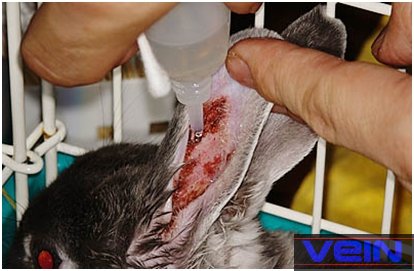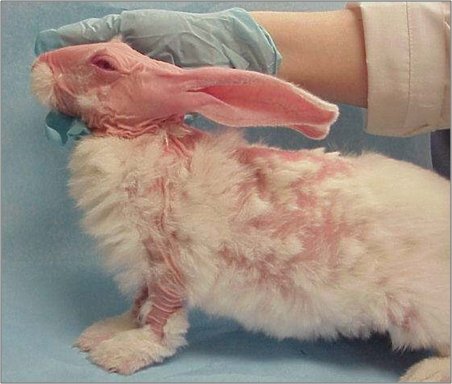Oormijt: Psoroptes
cuniculi
Esther van Praag Ph.D.
MediRabbit.com wordt uitsluitend gefinancierd door gevers.
Elke donatie, ongeacht hoe groot, wordt gewaardeerd en zal helpen bij de voortzetting van het onderzoek van de medische zorg en de gezondheid van konijnen.
Bedankt
|
Waarschuwing: deze tekst bevat foto’s die, voor
sommigen, storend kunnen zijn.
Oormijt, ook wel foutief oorschurft genoemd, wordt
veroorzaakt door een parasiet: het insect Psoroptes cuniculi. Deze
parasiet is universeel over de wereld verspreid.
Psoroptes sp. komt voornamelijk
aan de binnenkant van het oor voor en het is geen uitzondering dat slechts
één oor besmet is. Bij oudere of zwakke dieren komt het voor dat oormijt zich
verspreidt over het hele lichaam: hals, kop, rond om de anus, poten en
voeten. De parasiet leeft aan de oppervlakte van de huid, kauwt deze en boort
er gaten in. De verschillende levensstadia van deze parasiet verlopen als
volgt: ei, larf, protonymph tot volwassen mijt. Deze cyclus duurt ongeveer 2
tot 3 weken. De volwassen mijt leeft 4 tot 21 dagen, afhankelijk van
milieu-omstandigheden.
Klinische verschijnselen
Konijnen, die met
oormijt besmet zijn, schudden meer dan normaal met hoofd en oren en krabben
zichzelf tot en met het stadium van automutilatie. In het begin verschijnen
kleine droge korsten diep in het oorkanaal, later aan de binnenkant van het
oor. Rondom deze korsten is de huid haarloos (alopecia), hieronder is de huid
meestal vochtig en rood.
Als in dit stadium het
konijn niet behandeld wordt, groeien de korsten aan en kunnen, in extreme
gevallen, tot 2 cm dik worden. Deze korsten bevatten dode- en/of ontstoken
cellen, bloed, uitwerpselen en Psoroptes cuniculi zelf. Het oor kan
hierdoor niet meer recht op staan, alleen nog maar omlaag hangen. The scales/crust
should not be removed; if removed, they
leave bloody eroded skin. The crust will fall off within 10 days after the
first administration of oral or injected ivermectin. Earlier removal is also
very painful, and may lead to screaming.
Video
door D. Hanson De besmetting kan gepaard gaan met een bacteriele oof
huidschimmel oorinfecties. Als deze laatste niet behandeld wordt, kan de
bacteriële infectie zich tot het middenoor en binnenoor verspreiden, zodra
het trommelvlies doorbroken wordt.
Diagnose
Een visueel onderzoek van de huid is niet altijd voldoende
om de aanwezigheid te bevestigen; zo kunnen verschillende methodes toegepast
worden zodat minstens één parasiet of een ei gevonden wordt (zie 1.4). Kan
deze diagnose niet gesteld worden, dan is het beste een huidbiopsie te doen
van de plaats waar mijt vermoed wordt.
Bij zowel huid- en
schurftmijt besmetting kan de parasiet op de grond vallen en daardoor de omgeving besmetten. Het is
dus belangrijk om beiden het dier en de omgeving te behandelen. Als het
probleem verder niet opgelost kan worden, moet de besmettingshaard gezocht
worden. Dit kan zowel de aanwezigheid van een besmette hond of kat zijn,
evenals parasieten die de behandeling overleefd hebben.
Behandeling
De korsten moeten nooit
met de hand weggehaald worden!!!
Dit is erg pijnlijk en
verhoogt de kans op bacteriële infectie. Ze vallen automatisch af na een
behandeling met een van de bovengenoemde producten (zie video).
De beste behandeling
tegen Psoroptes cuniculi zijn producten op basis van avermectin:
• ivermectin: een
onderhuidse (SC) injectie (0.400 mg/kg). Deze injectie moet 3 maal, herhaald
worden, met tussenposen van 2 weken. Geïnjecteerde ivermectin helpt beter dan
oren te druppelen met ivermectin opgelost in olie, of een behandeling met zalf. Bij
beschadigde trommelvliezen mogen geen oordruppels gebruikt worden.
• selamectin: Stronghold®
(Europa) of Revolution® (US) - Pfizer, 15-18 mg/kg. Een eenmalige plaatselijke
behandeling is genoeg. Is dit niet het geval dan moet de behandeling na 30
dagen herhaald worden.
• moxidectin (Equest
Orales Gel® (Europa) of Quest® Gel (US) - Fort Dodge) Dit product heeft tot
nu toe geen bij-effecten getoond als het oraal wordt toegediend, in
tegenstelling tot onderhuidse injecties.
Deze 3 avermectin producten doden niet de eieren van deze
parasiet, maar de langdurige nawerking zal nieuw onstane larven doden, but
the drug remains in the tissue long enough to kill the larvae that emerge
from the eggs. Ivermectin diluted in mineral oil, applied directly on the ear, is
less effective than injected or oral ivermectin.
The use of over the counter products against mite or ear
mites should be avoided. Most contain pyrethrin. While one of the least toxic
insecticides for animals and rabbits, pyrethrins/pyrethroids are neurotoxins which lead to continuous
"firing" of nerves. Observed problems in rabbits include limb
paralysis, seizure, coma, tremor, sometimes death.
Many of those products contain additives that prolong the
effect of the pyrethrins, and inhibit the breakdown
of these products in the body. They can lead to toxic reactions in rabbits. Piperonyl butoxide is one of
them. If no immediate death, there should be **slow** recovery with time,
around 48 h. Ear mite infestation is accompanied by pain. An analgesic (pain
relief medication, e.g., carprofen, ketoprofen, meloxicam) should be administered.
Als het konijn pijn
lijdt, is het aangeraden om gedurende 2-3 dagen een pijnstillend middel
(carprofen, ketoprofen, meloxicam) te geven.
Een kleine bacteriële
oor infectie kan met oordruppels behandeld worden. Voor dat deze toegediend
worden, dienen de oren en vooral de trommelvliezen zeer goed nagekeken en
schoongemaakt te worden. Bij beschadigde trommelvliezen kunnen oordruppels
binnen enkele uren de dood van het konijn ten gevolge hebben.
Bij een grotere oorinfectie is het beter zowel
oordruppels als orale antibiotica te geven. Als pus in het oor aanwezig is, is the use of
enzymatic solution such as Zymox Otic and flushing of the ear is recommended. This will help
bring the medication deep in the ear canal. Het aangeraden
pus te isoleren
en te gebruiken
voor een bacteriële cultuur en een antibiotica
gevoeligheids test the secondary bacterial
infection is limited, it can be treated with antibiotic ear drops. It is
important to check the eardrum before administration. Some ear drops have,
indeed, ototoxic effects, and their administration when the eardrum is
ruptured can have a fatal outcome.
In case of inner ear infection, appropriate oral
antibiotics should be administered.
Ear mites can fall
off and contaminate the environment. While treating for mites, careful
cleaning of the cage and environment is recommended. Treatment of the environment
is important (boric acid such as Fleabusters®; Vet-Kem Acclaim Plus® - Sanofi; Staykil®
- Novartis; Indorex® - Virbac;
acaricide spray). When treating a carpet, vacuum
first in order to further penetration of the spray or powder. Shampooing and
steam cleaning are not ideal; their residual humidity can increase the mite
problem. During treatment of the environment, rabbits should be kept in
another part of the home to avoid the danger of contact with the products.
Dankbetuiging
Thanks are due to Zahi Aizenberg, DVM (The Koret School
of Veterinary Medicine, the Hebrew University of Jerusalem, Israel), to Dr.
Orlando Diaz, (www.lakehowellanimalclinic.com), to Akira Yamanouchi,
(Veterinary Exotic Information Network, https://vein.ne.jp/, Japan), to Crystal Gaydos
(www.bunnybunch.org, USA), to Linda Baley (USA), and to Christine Macey (USA)
for the permission to use their pictures. To Debbie Hanson for sharing the
news related to Parker, to Hugh Hanson, for sharing the video showing life ear
mites. To the rabbits Kaspi, Flora Adar, Parker and those whose name is
unknown, but were severely affected by ear mite.
Verdure informative ove over oormijt
bij konijn is hier te vinden: “Skin Diseases of Rabbits”, by E. van Praag, A. Maurer and T. Saarony, 408 pages, 2010. Verdere informatieBeck W. Farm animals as disease
vectors of parasitic epizoonoses and zoophilic
dermatophytes and their importance in dermatology. Hautarzt.
1999; 50(9):621-8.
Bowman DD, Fogelson ML, Carbone
LG. Effect of ivermectin on the control of ear mites (Psoroptes cuniculi)
in naturally infested rabbits. Am J Vet Res. 1992; 53(1):105-9.
Cutler SL. Ectopic Psoroptes
cuniculi infestation in a pet rabbit. J Small Anim Pract. 1998;
39(2):86-7.
Nfi AN. Ivomec, a treatment against rabbit mange. Rev Elev Med Vet Pays Trop. 1992; 45(1):39-41.
Pap L, Sarkozy P, Farkas R, Bleicher E, Szego A. Efficacy
of some pyrethroids against a strain of the rabbit
ear mite (Psoroptes cuniculi): an unusual cross-resistance pattern. Parasitol Res. 1997; 83(2):203-5.
Perrucci S, Cioni PL, Flamini G, Morelli I,
Macchioni G. Acaricidal
agents of natural origin against Psoroptes cuniculi. Parassitologia.
1994; 36(3):269-71.
Perrucci S, Cioni PL, Cascella A, Macchioni F. Therapeutic efficacy of linalool for the
topical treatment of parasitic otitis caused by Psoroptes cuniculi in
the rabbit and in the goat. Med Vet Entomol. 1997; 11(3):300-2.
Perrucci S, Flamini G, Cioni PL, Morelli I, Macchioni F, Macchioni G. In
vitro and in vivo efficacy of extracts
of Artemisia verlotorum
against Psoroptes cuniculi. Vet Rec. 2001; 148(26):814-5. No abstract available.
Sanders A, Froggatt P, Wall R,
Smith KE. Life-cycle stage morphology of Psoroptes
mange mites. Med Vet Entomol. 2000; 14(2):131-41.
Smith KE, Wall R, Berriatua E,
French NP. The effects of temperature and humidity on the
off-host survival of Psoroptes ovis and Psoroptes
cuniculi. Vet Parasitol. 1999;
83(3-4):265-75.
Wagner R, Wendlberger U. Field
efficacy of moxidectin in dogs and rabbits
naturally infested with Sarcoptes spp., Demodex spp. and Psoroptes spp. mites. Vet Parasitol. 2000; 93(2):149-58.
|
e-mail: info@medirabbit.com


























